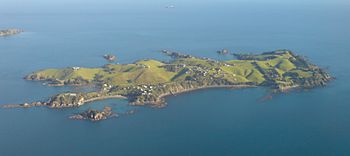Rākino Island facts for kids
Rākino Island is a small island located in the Hauraki Gulf / Tīkapa Moana. This gulf is an arm of the Pacific Ocean found northeast of Auckland, New Zealand.
Rākino is a quiet place, northeast of Motutapu Island. It is about 2.4 km (1.5 mi) long and 1.2 km (0.75 mi) wide. The island covers an area of 1.5 square kilometers. Two of its most popular bays are open to the public. There are also three other bays that can be reached from the sea. The public wharf is at the south end of Sandy Bay. A ramp for barges is at the western end of Sanford Way in Home Bay. The island is quite hilly. It has a rich layer of volcanic soil from Rangitoto Island. Beneath this is a thick layer of clay soil, which sits on top of greywacke rock. Most of Rākino Island is used for pasture, but it also has some areas of coastal pōhutukawa trees.
There are around 76 homes on Rākino Island. However, only 21 people live there all the time, based on 2019 numbers. Because it's small and has few permanent residents, and limited public ferry services, Rākino is not a place many people commute to. The people who live there enjoy its quietness and privacy.
Contents
Island History: From Governors to Communities
Early Ownership and Experiments
Sir George Grey, who was a governor of New Zealand, bought Rākino in 1862. He started planting trees and building a house in Home Bay. However, he soon became more interested in Kawau Island.
During the 1860s, some prisoners from the New Zealand Wars were brought to Auckland. A small group of these prisoners was sent to Rākino. They were given a house and gardening tools. But this plan did not work out well and was soon stopped. One record mentions that a prisoner named Ihaka "did not thrive much on the island and died there." It was thought he died from homesickness.
The Sanford Family's Time on Rākino
In 1874, Albert Sanford leased the island from Sir George Grey. Later, in 1904, his wife, Elizabeth Sanford, bought it. Albert and his family lived on Rākino for almost 80 years. Albert Sanford was one of the people who helped start Auckland's commercial fishing fleet. His company began on Rākino Island in 1881. He sold fish on the wharves at the end of Queen Street. The company, "Sanford Limited," officially became a business in 1904. The family home Albert built is still standing in Home Bay. It was made from kauri logs that were floated over from Mercury Bay on the Coromandel Peninsula.
A Vision for a Philanthropic Community
In 1963, Dr. Maxwell Rickard bought the island. He was the president of a group called the UPO (United Peoples' Organisation (Worldwide) Incorporated). His goal was to create a community that helped others. Dr. Rickard was a clinical psychologist and also performed as a hypnotherapist. He had big plans for the island. These included a clinic for people with nervous conditions, an international orphanage, a safe place for unmarried mothers, and homes for older people. However, these plans never happened. In 1965, the island was divided into 25 larger blocks of 10 acres (40,000 m2) and 125 smaller pieces of land. These smaller pieces sold for between £2500 and £6000.
Modern Communication on the Island
Communication was once a challenge on the island. To solve this, the world's first solar-powered telephone was installed there. Even though many people now use mobile phones, this special phone is still in use. Local calls to Auckland are free.
Island Biodiversity: Protecting Nature
In 2002, an important step was taken to protect Rākino Island's nature. The invasive Norwegian rat was completely removed from the island. This helps protect the native plants and animals.


